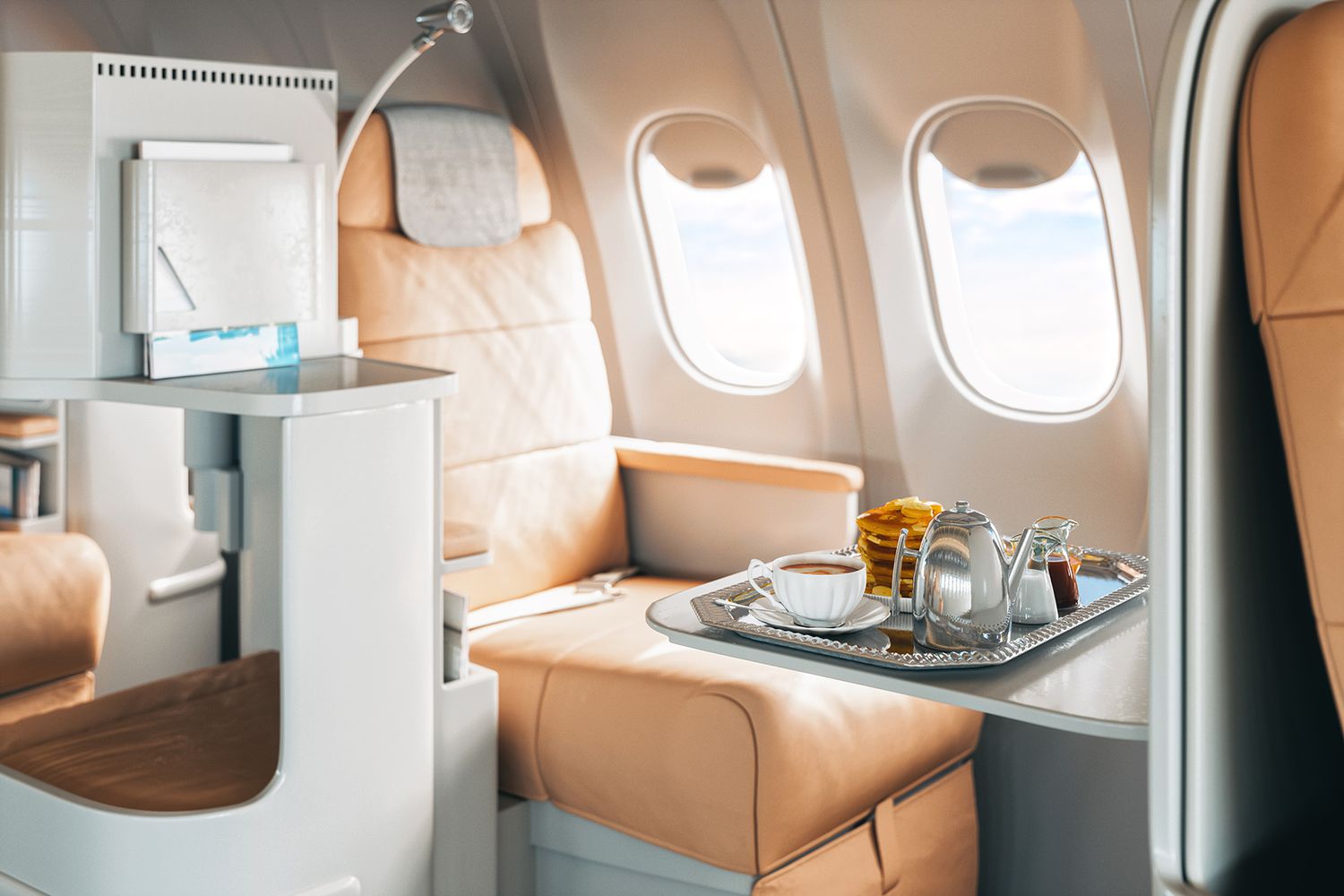Flying may not be the glamorous affair it once was—with wider economy seats, plenty of legroom, and more frequent meal service—but you’ll still find elements of that travel lifestyle in business and first-class cabins. “The very basics of premium seating areas like first and business class mean one thing: better overall experience,” says Katy Nastro, travel expert and spokesperson at Going.
Sometimes, that experience includes priority check-in, amenity kits, and an extra baggage allowance; it can also involve lie-flat seats and plated meals. The distinctions between business and first-class services, however, aren’t exactly black and white. “At the end of the day, the difference can just be a matter of marketing or airline services offered,” Nastro explains. “You often see domestic first class offered as the forward cabin, yet there are no lie-flat seats. Alternatively, on many international carriers, you see business class featuring lie-flat seats with perks like lounge access.”
While your in-flight experience will differ depending on the route or the airline, there are a few features and services you can typically expect. Below, we’re breaking down everything you need to know about the premium seats available on planes today—and how you can book them (or land an upgrade).
Bloomberg/Getty Images
Business Class
Pros
- Priority check-in and boarding
- Extra baggage allowance
- Typically lie-flat or angled seats with more legroom
- Plated meal service (depending on the route)
- Amenity kits
- Enhanced privacy
Cons
- Business-class seats, amenities, and services vary significantly by airline and aircraft
- Usually much more expensive than economy
- Limited seat availability
- Lounge access is not guaranteed
“While first class has always been touted as the ultimate luxury in flying, business classes have become more desirable for both airlines and passengers,” says Nastro. “Legacy carriers like Delta, United, and American have opted to increase their business-class seating arrangements versus first due to the increased willingness of travelers to spend on this category.”
Business-class seating arrangements and amenities will vary, but luxury travel advisor Kimberly Denison says there are a few things you may receive with your fare: “Business class delivers a premium experience with lie-flat seats, extra space, and amenities to make travel more comfortable, and travelers also enjoy airport perks such as lounge access, priority boarding, and, in some cases, expedited security or check-in.” She also notes that dining in business class is a “step above” what you’ll find in economy. “Airlines often collaborate with renowned chefs or mixologists to offer curated menus and specialty cocktails, and premium wine and spirits are standard,” she says, using Delta Airlines as an example. The airline recently announced that it will serve Taittinger Champagne in its Delta One cabins (which is considered business class) on international flights.
Domestic First Class
Pros
- More spacious and comfortable seats
- Plated meal service (depending on the route)
- Complimentary drinks, including alcoholic beverages
- Extra baggage allowance
- Priority check-in and boarding
- Not as expensive as business class or international first class
Cons
- Typically no lie-flat seats
- Lounge access is not guaranteed
- Usually not significantly different than premium economy
The best seats on domestic flights and select short-haul international flights are found in the first-class cabin—but the experience will shift by aircraft type and route. “Lie-flat seats, for example, are rare,” says Denison, “but when they are available, they’re usually only found on coast-to-coast flights.” If there’s one thing you can rely on when you pay for first-class fare, though, it’s priority check-in services and a comfortable, spacious seat that offers more legroom than economy. You’ll also receive complimentary alcoholic beverages and better food options. “Dining and beverage service will be improved over main cabin service, but not to the level of international business or first-class offerings,” she adds.
International First Class
Pros
- More privacy in the most luxurious seats
- Upscale dining
- Priority check-in and boarding
- Extra baggage allowance
- First-class-only lounges at some airports; general lounge access at others
- Amenity kits
Cons
- Only available on certain airlines and aircraft
- Typically the most expensive option
There’s no doubt about it: International first class is the most luxurious flying experience (outside of flying private). “Top international airlines like Emirates, Singapore Airlines, and Air France, to name a few, take comfort and exclusivity to another level. While business class on these airlines is already exceptional, their first-class cabins and perks redefine premium air travel,” says Denison—and those benefits typically start before you even get on the plane.
“First-class perks often include private lounges, chauffeur-driven private cars to and from the aircraft, dedicated jet bridges, and spacious suites with increased privacy,” she says. And when you’ve boarded? Get ready for “full turn-down service, complete with hotel-quality linens and pajamas, and luxury amenity kits in collaboration with high-end brands like Sisley or Bvlgari.”
Nastro notes that there’s constant debate over which airline offers the best international first-class experience, but she says it’s hard to argue with the fact that Etihad Airways takes the cake with their suites, offered only on a few dozen A380s. “This apartment in the sky offers private minibars, more space than some Manhattan apartments, and the ability to shower—yes, that’s right, shower—mid-flight,” she says.
NurPhoto/Getty Images
Booking Tips
Before you book a premium cabin, think about whether the splurge is worth it or if it makes sense for that particular flight. For instance, you’ll likely reap more benefits if you fly business on an international red-eye flight—that lie-flat seat will ensure you get a few more hours of shuteye—than you will by sitting in first class on a two-hour domestic flight. But if being in first or business is a non-negotiable, Denison shares that you probably shouldn’t wait or hope for an upgrade. “Premium cabin inventory is limited, and waiting too long may mean missing out on it entirely,” she says.
What to Know About Upgrades
While you can purchase business or first-class fare when booking your flight (either with miles or money), there are a few other ways you can find yourself in the top cabins. Here’s what to know about upgrades.
How to Get Upgraded for Free
“The most reliable way to earn a complimentary upgrade is through elite status with an airline,” says Denison. To get status quicker—and increase your potential for getting upgraded on domestic flights and limited short-haul international trips—you can use an airline credit card or earn miles by linking car rentals and ride-sharing services to your frequent-flier account.
That said, Nastro warns this long-term strategy has “become more of a losing battle than a winning one.” With more loyalty members than ever before, she says the competition for these types of perks has become “brutal.” Plus, she adds, “Airlines are finding ways to market a portion of seats traditionally given for elite upgrade purposes to the masses by selling the ‘upgrade’ for a discounted cash price.”
Another way you might score a free upgrade is by accepting a voluntary bump on an oversold flight. The airline will likely give volunteers a cash incentive, but you can also ask about an upgraded seat if you accept the deal.
Paying for Upgrades
There are several different ways you can pay for an upgrade to business or first class—and Denison admits it can be confusing to navigate. “I often recommend that my clients monitor the airline app for available upgrades leading up to their departure. Another opportunity to snag an upgrade, and often at the best price, is at the airport during check-in,” she says.
Sometimes this works, but Nastro says you can’t always count on it: “Airlines want to try and sell as many premium seats as possible at the highest price someone is willing to pay, so there is not always availability in a higher class for this ‘discounted’ price. Yet, if you hit it right, it could be less expensive than buying a business-class ticket outright for that same flight,” she tells Travel + Leisure.
Bidding for Upgrades
You’ll typically only see the option to bid for an upgrade when you’re flying abroad with an international carrier—or with Hawaiian Airlines, the only domestic carrier with a bidding program. “On the limited flights it’s available for, you would need to bid per segment, not per ticket, so essentially, each flight you board would need to have a bid placed,” says Nastro, who describes it as “sort of like an eBay auction.”
“You come in at an amount within the threshold an airline sets and hope you’ve bid enough, but likely won’t find out until about 48 to 72 hours from the flight,” she explains. While she shares that there’s “no real strategy to placing a bid,” she does have three things travelers should keep in mind. The first is to look at the seat map and see what availability for that cabin looks like; if only one seat is open, the bid will likely need to be higher. The second is to bid above the minimum if you can, since most people will try to pay as little as possible. Finally, she reminds travelers to “double-check the price to purchase an upgrade outright before placing a bid since sometimes it’s relatively close (or even lower) than the minimum bid.”


